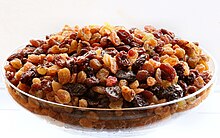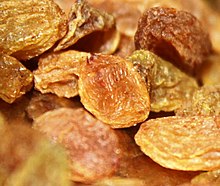This is an old revision of this page, as edited by Mayonegg (talk | contribs) at 18:35, 29 September 2024. The present address (URL) is a permanent link to this revision, which may differ significantly from the current revision.
Revision as of 18:35, 29 September 2024 by Mayonegg (talk | contribs)(diff) ← Previous revision | Latest revision (diff) | Newer revision → (diff) Dark-colored dried large grape For other uses, see Raisin (disambiguation).


A raisin is a dried grape. Raisins are produced in many regions of the world and may be eaten raw or used in cooking, baking, and brewing. In the United Kingdom, Ireland, New Zealand, Australia and South Africa, the word raisin is reserved for the dark-colored dried large grape, with sultana being a golden-colored dried grape, and currant being a dried small Black Corinth seedless grape.
Etymology
The word raisin dates back to Middle English and is a loanword from Old French; in modern French, raisin means "grape", while a dried grape is a raisin sec, or "dry grape". The Old French word, in turn, developed from the Latin word racemus, which means "a bunch of grapes."
Varieties
| This section needs additional citations for verification. Please help improve this article by adding citations to reliable sources in this section. Unsourced material may be challenged and removed. Find sources: "Raisin" – news · newspapers · books · scholar · JSTOR (December 2021) (Learn how and when to remove this message) |

Raisin varieties depend on the types of grapes used and appear in a variety of sizes and colors, including green, black, brown, purple, blue, and yellow. Seedless varieties include sultanas (the common American type is known as Thompson Seedless in the United States), Zante currants (black Corinthian raisins, Vitis vinifera L. var. Apyrena), and Flame grapes. Raisins are traditionally sun-dried but may also be artificially dehydrated.
Golden raisins are generally dried in dehydrators with controlled temperature and humidity, which allows them to retain a lighter color and more moisture. They are often treated with sulfur dioxide after drying.
Black Corinth or Zante currants are small, sometimes seedless, raisins that are much darker and have a tart, tangy flavor. They are usually called currants. Muscat raisins are larger and sweeter than other varieties.
Grapes used to produce raisins in the Middle East and Asia include the large black monukka (or manucca) grapes that produce large raisins.
Processing
Raisins are produced commercially by drying harvested grape berries. For a grape berry to dry, water inside the grape must be removed completely from the interior of the cells onto the surface of the grape where the water droplets can evaporate. However, this diffusion process is very difficult because the grape skin contains wax in its cuticle, which prevents the water from passing through. In addition to this, the physical and chemical mechanisms located on the outer layers of the grape are adapted to prevent water loss. The three steps to commercial raisin production include pre-treatment, drying, and post-drying processes.
Pre-treatment
Pre-treatment is a necessary step in raisin production to ensure the increased rate of water removal during the drying process. A faster water removal rate decreases the rate of browning and helps to produce more desirable raisins. The historical method of completing this process was developed in the Mediterranean and Asia Minor areas by using a dry emulsion cold dip made of potassium carbonate and ethyl esters of fatty acids. This dip was shown to increase the rate of water loss by two- to three-fold.
Recently, new methods have been developed such as exposing the grapes to oil emulsions or dilute alkaline solutions. These methods can encourage water transfer to the outer surface of grapes which helps to increase the efficiency of the drying process.
| Nutritional value per 100 g (3.5 oz) | |||||||||||||||||||||||||||||||||||||||||||||||||||||||
|---|---|---|---|---|---|---|---|---|---|---|---|---|---|---|---|---|---|---|---|---|---|---|---|---|---|---|---|---|---|---|---|---|---|---|---|---|---|---|---|---|---|---|---|---|---|---|---|---|---|---|---|---|---|---|---|
| Energy | 299 kcal (1,250 kJ) | ||||||||||||||||||||||||||||||||||||||||||||||||||||||
| Carbohydrates | 79.3 g | ||||||||||||||||||||||||||||||||||||||||||||||||||||||
| Sugars | 65.2 g | ||||||||||||||||||||||||||||||||||||||||||||||||||||||
| Dietary fiber | 4.5 g | ||||||||||||||||||||||||||||||||||||||||||||||||||||||
| Fat | 0.25 g | ||||||||||||||||||||||||||||||||||||||||||||||||||||||
| Protein | 3.3 g | ||||||||||||||||||||||||||||||||||||||||||||||||||||||
| |||||||||||||||||||||||||||||||||||||||||||||||||||||||
| Other constituents | Quantity | ||||||||||||||||||||||||||||||||||||||||||||||||||||||
| Water | 15.5 g | ||||||||||||||||||||||||||||||||||||||||||||||||||||||
Link to USDA Database entry | |||||||||||||||||||||||||||||||||||||||||||||||||||||||
| Percentages estimated using US recommendations for adults, except for potassium, which is estimated based on expert recommendation from the National Academies. | |||||||||||||||||||||||||||||||||||||||||||||||||||||||
Drying

The three types of drying methods are: sun drying, shade drying, and mechanical drying. Sun drying is an inexpensive process; however, environmental contamination, insect infections, and microbial deterioration can occur and the resulting raisins are often of low quality. Additionally, sun drying is a slow process and may not produce the most desirable raisins.
Mechanical drying can be done in a safer and more controlled environment where rapid drying is guaranteed. One type of mechanical drying is to use microwave drying. Water molecules in the grapes absorb microwave energy resulting in rapid evaporation. Microwave drying produces puffed raisins.
Post-drying processes
After the drying process is complete, raisins are sent to processing plants where they are cleaned with water to remove any foreign objects that may have become embedded during the drying process. Stems and off-grade raisins are also removed. The washing process may cause rehydration, so another drying step is completed after washing to ensure that the added moisture has been removed.
All steps in the production of raisins are very important in determining the quality of raisins. Sometimes sulfur dioxide is applied to raisins after the pre-treatment step and before drying to decrease the rate of browning caused by the reaction between polyphenol oxidase and phenolic compounds. Sulfur dioxide also helps to preserve flavor and prevent the loss of certain vitamins during the drying process.
Production
Global production of raisins in 2020–21 was 1.2 million tonnes, led by Turkey, the United States, Iran, and India as the largest producers.
Nutrition
Raisins are composed of 15% water, 79% carbohydrates (including 4% fiber), and 3% protein, and contain negligible fat. In a reference amount of 100 grams (3.5 oz), raisins supply 299 kilocalories and moderate amounts (10–19% DV) of the Daily Value for several dietary minerals, riboflavin, and vitamin B6.
Toxicity in animals
Main article: Grape and raisin toxicity in dogsRaisins can cause kidney failure in both cats and dogs. The cause of this is not known.
Gallery

-
 Common commercial raisins
Common commercial raisins
-
 Chunche, ventilated sheds for drying grapes into raisins in Xinjiang
Chunche, ventilated sheds for drying grapes into raisins in Xinjiang
-
 Raisins offered for sale at a market in Taliparamba, India
Raisins offered for sale at a market in Taliparamba, India
See also
- Dried fruit
- Raisin cake
- Snap-dragon, a Victorian parlour game that involved raisins being plucked from a bowl of burning brandy
- Sun-Maid, a popular brand of raisins available in North America and the United Kingdom
- The California Raisins, a fictional music group of anthropomorphized raisins created by CalRAB to promote the food on TV
- The chocolate-covered raisin, a candy made by coating the dried fruit in chocolate
- Oatmeal raisin cookie
References
- bakeryandsnacks.com. "Raisin the stakes in 2023: South African sultanas take the lead as the New Year ingredient". bakeryandsnacks.com. Retrieved 20 March 2023.
- Dom Costello. "Kew Gardens explanation". Royal Botanic Gardens, Kew. Archived from the original on 5 September 2012. Retrieved 16 January 2013.
- ^ Harper, Douglas. "raisin". Online Etymology Dictionary.
- "Types of Raisins: Currants, Golden Seedless, and More". Berkeley Wellness. Remedy Health Media. Archived from the original on 21 September 2017. Retrieved 20 September 2017.
- ^ Esmaiili, M.; Sotudeh-Gharebagh, R.; Cronin, K.; Mousavi, M. A. E.; Rezazadeh, G. (2007). "Grape Drying: A Review". Food Reviews International. 23 (3): 257. doi:10.1080/87559120701418335. S2CID 83652015.
- ^ Christensen, L.P., and Peacock, W.L. (20 April 2013) "The Raisin Drying Process" Archived 12 June 2013 at the Wayback Machine. Raisin Production Manual, University of California at Davis.
- United States Food and Drug Administration (2024). "Daily Value on the Nutrition and Supplement Facts Labels". FDA. Archived from the original on 27 March 2024. Retrieved 28 March 2024.
- National Academies of Sciences, Engineering, and Medicine; Health and Medicine Division; Food and Nutrition Board; Committee to Review the Dietary Reference Intakes for Sodium and Potassium (2019). "Chapter 4: Potassium: Dietary Reference Intakes for Adequacy". In Oria, Maria; Harrison, Meghan; Stallings, Virginia A. (eds.). Dietary Reference Intakes for Sodium and Potassium. The National Academies Collection: Reports funded by National Institutes of Health. Washington, DC: National Academies Press (US). pp. 120–121. doi:10.17226/25353. ISBN 978-0-309-48834-1. PMID 30844154. Retrieved 5 December 2024.
- "Estimated world raisin/sultana/currant production 2020–2021". International Nut and Dried Fruit Council. 24 February 2021. Retrieved 12 December 2021.
- DiBartola, Stephen P. (2012). Fluid, electrolyte, and acid-base disorders in small animal practice (4th ed.). St. Louis, Mo.: Saunders/Elsevier. p. 155. ISBN 978-1-4377-0654-3.